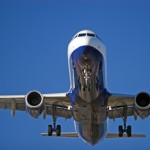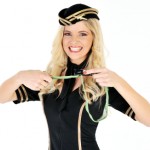So here you are, 68 years old, finally retired from your forty-three year career and just starting that long-awaited trip with your spouse. The Far East beckons as your board that plane headed to Shanghai. Sure, you've never gotten around to losing that extra forty pounds, but as soon as you get back you're going to join a gym and work out three, maybe four times a week. Perhaps they can help you with a Stop Smoking program too.
Six hours later, 42,000 feet above the Pacific, you're in trouble. It started with that meal you bought at the airport and brought aboard; a strange, uncomfortable feeling in your chest and now you're sweating and it feels like an elephant is standing on you, with pain coming down your left arm as well.
So this scenario happens over and over. A passenger on a commercial airline has chest pain or, perhaps, shifting gears, is a diabetic who took his or her medicine, but, in the rush of things, didn't eat before starting on their journey and now has low blood sugar. Or someone may have a stoke or a seizure or a miscarriage.
How prepared is the plane's crew for the care needed? Do they have adequate training or supplies?
A recent article brought back memories of flying across the Pacific during my Active Duty days. On seven of eight legs, going from the United States to the Philippines or back the other way, I ended up being identified as a physician and needed to help. That's also happened on a ship cruising down the Danube.
Most of the time the person who needed medical attention wasn't critically ill. But in one instance, on my last flight back to the States, a Marine went into premature labor, I had delivered fifty babies, but none for the preceding fourteen years. That time I found well-trained help; our head nurse in Labor and Delivery saw me walking down the aisle and said she'd take over.
Another episode had a young troop with acute gastroenteritis; I made the equivalent of Gatorade from supplies on the plane, gave him the rehydration fluid and had two burly young men sit next to him right in front of a bathroom.
But the question I always wondered about in those days was what would I do if someone had a cardiac arrest while we were 3,000 miles from a hospital and eight miles above sea level. This was before the advent of AEDs, automated external defibrillators, the devices that can determine if a person's abnormal heart rhythm is one that could respond to an electrical shock.
I also flew on one Air Force aeromedical evacuation flight, from Clark AFB, north of Manila, to Bali, but in that case I knew I was there to give or supervise medical care and had a crew that included flight nurses and technicians. They were used to such flights and, in those days, rarely had a doc onboard. Many of our staff members went out from Clark on similar flight to a variety of locations in the Far East.
That was long before the days of "critical care in the air," pioneered by one of my past Air Force commanders. The USAF's 59th Medical Wing (formerly known as Wilford Hall Medical Center) now has 15 three-member teams with a critical care physician, critical care nurse and a respiratory tech equipped with all they might need to support three critically ill patients for 72 hours.
But what if you're in a civilian airplane and have a major medical emergency?
A 2oo6 Federal Aviation Administration (FAA) Advisory Circular dated January 12, 2006 mandated supplies that must be carried on commercial flights. It's directed at planes with at least 30 passengers and one or more flight attendants. An AED, blood pressure cuff, stethoscope, CPR masks (to protect those doing CPR, not for those needing it), a few needles and syringes, protective gloves, 4 adult aspirin, 4 other non-narcotic pain pills, oral and injectable antihistamines, an asthma inhaler, 10 nitroglycerin tablets, 50 cc of a 50% dextrose (sugar) solution, 500 cc of a saline solution and a few cardiac drugs are required.
Plus one set of basic instructions on how to use the drugs in the kit.
But who is going to use that kit of emergency materials? Most of the time it would be a passenger, hopefully a physician or nurse or EMT. The FAA states "It is unrealistic to expect flight attendants to achieve the same level of proficiency as emergency medical personnel who preform medical procedures on a routine basis." The circular goes on to say, "Flight attendants should not be expected to administer medications or to start IVs."
Since then a number of airlines have upgraded the training of their staff and added extra supplies to those the FDA requires. I'd like to see a glucometer in the list.
A recent article which caught my attention was titled "Outcomes of Medical Emergencies on Commercial Airline Flights," printed online by the New England Journal of Medicine (NEJM) on May 30, 2013. It began by stating two and three quarters billion passengers take to the skies every year . The piece tracked nearly three years of in-flight emergency calls from both domestic and international airlines (five airlines carrying roughly 10% of all such passengers) to a medical communications center staffed by physicians.
Overall there was one medical emergency per just over 600 flights; nearly half of the instances resulted in physicians providing help in the air and only 7.3% caused an aircraft diversion, i.e., emergency landing for medical care. Out of nearly 11,000 passengers for whom followup date was available, roughly three-fourths were met by EMS on landing and 2804 were then transport to an emergency room.
Only thirty-six died and of those 30 died in the air. That's less than 1/2 of one percent of those who needed medical attention.
The ability for flight crew to communicate with physicians on the ground was invaluable, especially as physicians passengers were available less than half of the time and nurses about 20% of cases.
Shortly before the NEJM piece came out, there was an article in The Atlantic, "Medical Emergencies at 40,000 feet." This one recounted the experiences of Dr. Celine Gounder, a Baltimore-based infectious disease and public health specialist.
I read her article and noted that the 1998 Aviation Medical Assistance Act protects medical personnel providing in-flight care from legal liability except in cases of gross negligence or willful misconduct.
Flight personnel can help physician/nurse volunteers by automatically contacting medical communications centers. A number of physicians who fly may be like me, fifteen years past the last time I rendered any medical care and nearly thirty years past my last ICU experience. And even a practicing ENT doc (for example) may not be comfortable giving cardiac meds without the assistance of a ground-based expert.
But as our population ages while still enjoying travel, the issue isn't going to go away.



